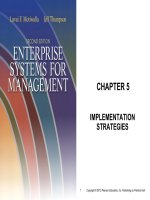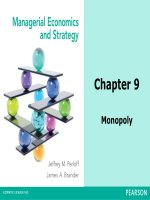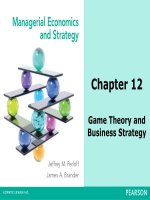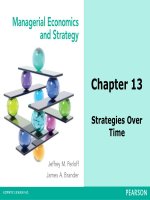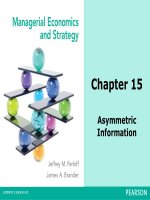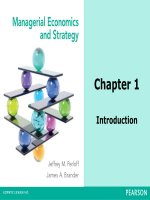Career development interventions 5th by spence niles and bowlsbey chapter 05
Bạn đang xem bản rút gọn của tài liệu. Xem và tải ngay bản đầy đủ của tài liệu tại đây (197.46 KB, 26 trang )
Career Development Interventions
5th Edition
Spence G. Niles and JoAnn E. Harris-Bowlsbey
Publisher to insert
cover image here
Chapter 5
Assessment and
Career Planning
Developed by:
Jennifer Del Corso
Copyright © 2017, 2013, 2009 by Pearson Education, Inc. All Rights Reserved
Introduction
• Assessment is the use of any formal or
informal technique to collect data about a
client.
• It is a tool of the trait-and-factor approach,
which had its beginning with the three-step
career choice process introduced by Frank
Parsons.
Career Development Interventions, 5th Edition
Spencer G. Nile and JoAnn E. Harris-Bowlsbey
Copyright © 2017, 2013, 2009 by Pearson Education,
Inc.
All Rights Reserved
Guidelines for Use of Trait-andFactor Approach in 21st Century
• Test data
are only one piece of a much larger puzzle.
should be used less for prediction and more for identifying new
options.
• The client should be more involved in making the
decision about whether to use assessment and for
what purposes.
• The changing demographics of the United States
necessitate the need for even more preparation
when selecting and using assessments in counseling
Career Development Interventions, 5th Edition
Spencer G. Nile and JoAnn E. Harris-Bowlsbey
Copyright © 2017, 2013, 2009 by Pearson Education,
Inc.
All Rights Reserved
Assessment and the Career
Planning Process
• Step 1 - may use an instrument to measure
career maturity, career beliefs or decisionmaking style
• Step 2 - may use inventories to measure
interests, abilities, skills, work values, or
personality type
Career Development Interventions, 5th Edition
Spencer G. Nile and JoAnn E. Harris-Bowlsbey
Copyright © 2017, 2013, 2009 by Pearson Education,
Inc.
All Rights Reserved
Assessment and the Career
Planning Process
• Step 3 - Score report from inventories given in
Step 2 will suggest occupations.
• Step 4 - Assessment not likely to be used.
• Step 5 - Inventories of work-related values may
be used to reduce number of options.
Career Development Interventions, 5th Edition
Spencer G. Nile and JoAnn E. Harris-Bowlsbey
Copyright © 2017, 2013, 2009 by Pearson Education,
Inc.
All Rights Reserved
Assessment and the Career
Planning Process
• Step 6 - Tests that predict success in college
or measure achievement in specific subject
matter may be used.
• Step 7 - Instruments that measure work
skills or personality type may be used.
Career Development Interventions, 5th Edition
Spencer G. Nile and JoAnn E. Harris-Bowlsbey
Copyright © 2017, 2013, 2009 by Pearson Education,
Inc.
All Rights Reserved
Purposes of Assessment
• Counselors can learn more about the needs
of students or clients.
• Counselors can learn more about the
characteristics of clients (interests,
abilities, skills, values), and clients can
learn more about themselves.
• Counselors can measure the progress of an
individual or a group in matters related to
career planning.
Career Development Interventions, 5th Edition
Spencer G. Nile and JoAnn E. Harris-Bowlsbey
Copyright © 2017, 2013, 2009 by Pearson Education,
Inc.
All Rights Reserved
Counselor Responsibilities
• Follow ethical guidelines provided by
professional associations
• Possess knowledge
basic principles of assessment
details of specific instruments to be used
how to prepare clients/students
how to administer properly
how to interpret properly
follow through with clients appropriately after the
assessment
Career Development Interventions, 5th Edition
Spencer G. Nile and JoAnn E. Harris-Bowlsbey
Copyright © 2017, 2013, 2009 by Pearson Education,
Inc.
All Rights Reserved
Clients’ Rights in Assessments
• Old model of the trait-and-factor approach (often
called the “test-‘em and tell-‘em” approach) should
be replaced with a view of assessment that:
• a) respects assessment is just one of the tools
available to assist clients,
• b) should be administered with the person’s full
understanding of its purpose,
• c) prepares the client, administers the instrument
corrects,
• d) treats the results in the confidential manner, and
• e) interprets the results in a knowledgeable way
Career Development Interventions, 5th Edition
Spencer G. Nile and JoAnn E. Harris-Bowlsbey
Copyright © 2017, 2013, 2009 by Pearson Education,
Inc.
All Rights Reserved
Characteristics of Informal
Assessment
• Instruments not subjected to scientific
study
• Results for one person cannot be compared
with those of others
• No standard linkage between results and
occupational choices
• No standard way to interpret results
• Low cost or free materials
Career Development Interventions, 5th Edition
Spencer G. Nile and JoAnn E. Harris-Bowlsbey
Copyright © 2017, 2013, 2009 by Pearson Education,
Inc.
All Rights Reserved
Types of Informal Assessment
• Checklists
• Games
• Career fantasies
• Forced-choice activities
• Card sorts
• Structured interviews
Career Development Interventions, 5th Edition
Spencer G. Nile and JoAnn E. Harris-Bowlsbey
Copyright © 2017, 2013, 2009 by Pearson Education,
Inc.
All Rights Reserved
Characteristics of Formal
Assessment
• May be timed, standardized tests or non-timed,
standardized inventories.
• Standardized way to administer and interpret the
instrument
• Known validity (instrument measures what it claims to
measure)
• Known reliability (results of a later administration will
be highly similar to those of first administration)
• Test-retest reliability (defined as the correlation
between two measurements obtained in the same
manner)
Career Development Interventions, 5th Edition
Spencer G. Nile and JoAnn E. Harris-Bowlsbey
Copyright © 2017, 2013, 2009 by Pearson Education,
Inc.
All Rights Reserved
Characteristics of Formal
Assessment
• Fairness related to diversity (instrument
adequately researched with kinds of
individuals who will later take the
instrument)
• Measures of comparison (compares the
scores of one individual with those of
others)
Career Development Interventions, 5th Edition
Spencer G. Nile and JoAnn E. Harris-Bowlsbey
Copyright © 2017, 2013, 2009 by Pearson Education,
Inc.
All Rights Reserved
Common Interest Inventories
• Career Assessment Inventory (CAI)
• Career Occupational Preference Survey
(COPS)
• Career Quest
• Harrington-O’Shea Career Decision-Making
System (CDMS)
Career Development Interventions, 5th Edition
Spencer G. Nile and JoAnn E. Harris-Bowlsbey
Copyright © 2017, 2013, 2009 by Pearson Education,
Inc.
All Rights Reserved
Common Interest Inventories
continued
• Interest Determination, Exploration, and
Assessment System (IDEAS)
• Interest Explorer
• Jackson Vocational Interest Survey (JVIS)
• Kuder Career Search with Person Match
• O*Net Interest Profiler
Career Development Interventions, 5th Edition
Spencer G. Nile and JoAnn E. Harris-Bowlsbey
Copyright © 2017, 2013, 2009 by Pearson Education,
Inc.
All Rights Reserved
Common Interest Inventories
continued
• Self-Directed Search (SDS)
• Strong Interest Inventory (SII)
• Unisex Edition of the ACT Interest Inventory
(UNIACT)
• Vocational Interest Inventory
Career Development Interventions, 5th Edition
Spencer G. Nile and JoAnn E. Harris-Bowlsbey
Copyright © 2017, 2013, 2009 by Pearson Education,
Inc.
All Rights Reserved
Common Instruments to Measure
Skills and Abilities
Campbell Interest and Skill Survey (CISS)
SkillScan
WorkKeys
Passion Revealer
The Armed Services Vocational Aptitude
Battery (ASVAB)
• Career Planning Survey
• O*Net Ability Profiler
•
•
•
•
•
Career Development Interventions, 5th Edition
Spencer G. Nile and JoAnn E. Harris-Bowlsbey
Copyright © 2017, 2013, 2009 by Pearson Education,
Inc.
All Rights Reserved
Other Inventories
• Myers-Briggs Type Indicator (MBTI) measures personality type
• O*Net Work Importance Profiler - measures
the importance of six work values
• Super’s Work Values Inventory - measures
the importance of 12 work values
Career Development Interventions, 5th Edition
Spencer G. Nile and JoAnn E. Harris-Bowlsbey
Copyright © 2017, 2013, 2009 by Pearson Education,
Inc.
All Rights Reserved
Steps of the Assessment Process
• Prepare students/clients for assessment
• Administer instrument(s) properly
• Interpret instrument(s) properly
• Follow through to assist students/clients to
use results for action planning
Career Development Interventions, 5th Edition
Spencer G. Nile and JoAnn E. Harris-Bowlsbey
Copyright © 2017, 2013, 2009 by Pearson Education,
Inc.
All Rights Reserved
Ways to Administer and Interpret
Assessment
• Print form - manual or optical scoring;
counselor interpretation
• Computer (standalone or networked) administration and scoring; counselor or
computer interpretation
• Internet - administration, scoring, and
interpretation
Career Development Interventions, 5th Edition
Spencer G. Nile and JoAnn E. Harris-Bowlsbey
Copyright © 2017, 2013, 2009 by Pearson Education,
Inc.
All Rights Reserved
Advantages of Internet Delivery
• Can be taken from anywhere 24/7
• Immediate scoring and feedback
• Standard interpretation, though customized
• Capability to share report with others
electronically
Career Development Interventions, 5th Edition
Spencer G. Nile and JoAnn E. Harris-Bowlsbey
Copyright © 2017, 2013, 2009 by Pearson Education,
Inc.
All Rights Reserved
No-Fee Assessment Websites
• University of Waterloo Career Services www.cdm.uwaterloo.ca/steps.asp
• CareerKey - www.ncsu.edu/careerkey
• University of Missouri Career Center (Select Career
Interests Game)
• Motivational Assessment of Personal
Potential - www.assessment.com
Career Development Interventions, 5th Edition
Spencer G. Nile and JoAnn E. Harris-Bowlsbey
Copyright © 2017, 2013, 2009 by Pearson Education,
Inc.
All Rights Reserved
For-Fee Assessment Websites
• DISCOVER – www.act.org
• Kuder Career Planning System www.kuder.com
• Self-Directed Search - www.self-directedsearch.com
Career Development Interventions, 5th Edition
Spencer G. Nile and JoAnn E. Harris-Bowlsbey
Copyright © 2017, 2013, 2009 by Pearson Education,
Inc.
All Rights Reserved
Assessment Results
• Results typically come in print form from the website or
computer from which the assessment was taken
• Raw scores - provide a tally of responses in a specific category;
examinee cannot compare personal scores with those of others
• Percentile scores - compare the scores of one person with those
of a selected norm group
• Stanines – a way to divide percentiles into 9 ranges
• Standard score – a way to indicate how far (in standard
deviations) an individual’s score is from the middle (50 th
percentile) of a distribution of scores
• Band of confidence – a range within which an individual score
fall
Career Development Interventions, 5th Edition
Spencer G. Nile and JoAnn E. Harris-Bowlsbey
Copyright © 2017, 2013, 2009 by Pearson Education,
Inc.
All Rights Reserved
Steps in Selection of Instruments
• Determine purpose of assessment.
• Consider characteristics of those to be
assessed.
• Determine if norm group for instrument
includes characteristics of persons to be
tested.
• Investigate the reliability and validity of the
instrument.
Career Development Interventions, 5th Edition
Spencer G. Nile and JoAnn E. Harris-Bowlsbey
Copyright © 2017, 2013, 2009 by Pearson Education,
Inc.
All Rights Reserved
